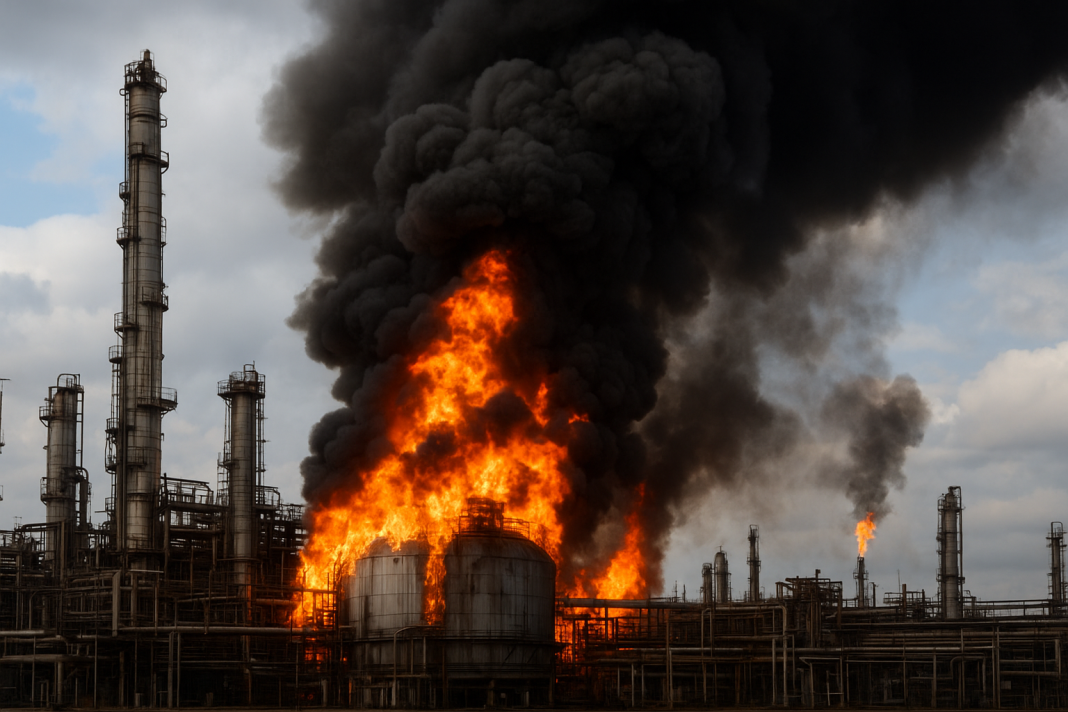Ukrainian forces launched overnight strikes on September 7 against two important energy facilities deep inside Russian territory.
Major Energy Sites Targeted in Overnight Strikes
The first strike hit the Ilsky oil refinery in Russia’s Krasnodar Krai, while the second targeted the “8-N” oil pipeline control station near the village of Naitopovichi in Bryansk Oblast.
Both facilities are directly linked to supplying fuel for Russian troops in Ukraine. According to Ukraine’s General Staff, these attacks are part of an ongoing effort to weaken Russia’s war machine by striking its energy backbone.
The “8-N” control station, part of the “Steel Horse” pipeline complex, suffered multiple hits. Reports say a fire broke out near the station’s pumping area and tank farm after the strikes. Ukrainian missile forces, artillery, and drone units worked together in carrying out this operation.
The Ilsky oil refinery, one of the largest in southern Russia, was also hit. Videos and photos circulating on social media showed flames rising high above the refinery after the strike. Russian regional officials claimed a “technological workshop” had caught fire, though no casualties were reported.
Ukraine’s Zaporizhzhia suffers heaviest overnight strike with missiles and Shahed drones
Both of these energy hubs play a crucial role in transporting and processing fuel for military use, making them high-value targets.
Strategic Importance of the Struck Facilities
The “8-N” control station is considered strategically vital because it connects to Belarusian refineries and helps move oil products into Russia. The facility belongs to the large “Steel Horse” pipeline, which has a pumping capacity of 10.5 million tons of fuel. This station supports not only Russian supply chains but also the transport of oil products from neighboring Belarus, including from the Mozyr and Novopolotsk refineries.
By hitting the control station, Ukrainian forces disrupted the flow of oil products through one of the key arteries that supply Russian troops. Footage of the strike’s aftermath showed large explosions and fires at the site.
The Ilsky oil refinery, meanwhile, processes around 6.42 million tons of oil every year. Located about 500 kilometers from Ukrainian-controlled territory, it is one of the most productive refineries in southern Russia. The facility provides more than six million tons of fuel annually, much of which is linked to military operations.
Reports of the refinery fire first surfaced on Russian social media before Ukraine confirmed the strike. Witnesses shared images of huge flames lighting up the night sky. Despite local officials downplaying the incident as a workshop fire, the timing matched Ukraine’s announced operation.
Ukrainian forces hit Ryazan oil refinery in Russia raising concerns over fuel infrastructure
This refinery has been struck several times in the past, including a major incident in July, when one of its workshops was hit by a drone. With this latest strike, Ukraine once again demonstrated its ability to hit deep inside Russian territory.
Expanding Strikes on Russian Energy Network
These attacks are not isolated events. Ukrainian forces have steadily expanded their long-range operations against Russian oil refineries, depots, and supply hubs. The goal, according to Ukraine’s General Staff, is to reduce the fuel available for Russian troops and cut into Moscow’s ability to finance its war.
Krasnodar Krai, where the Ilsky refinery is located, has increasingly become a hotspot for Ukrainian drone activity. Its position along the Black Sea makes it strategically significant, and its large industrial facilities make it a key target.
In Bryansk Oblast, the hit on the “8-N” control station adds to a string of recent strikes on Russian infrastructure. Fires at tank farms and pumping stations highlight the vulnerability of fuel networks that run hundreds of kilometers across Russian territory.
Alongside these energy-focused strikes, Ukrainian forces also hit Russian personnel positions and logistics depots in Kursk Oblast. This shows that the campaign is not only about energy but also about disrupting supply chains and frontline support.
Peter Navarro sparks outrage with claim Ukraine conflict is ‘Modi’s war’; India hits back
In August alone, Ukraine managed to hit at least 12 oil refineries across Russia. Those attacks temporarily shut down facilities that represent more than 17% of Russia’s oil processing capacity. That equals about 1.1 million barrels of fuel per day, a significant figure in terms of economic and military impact.
By intensifying these strikes, Ukraine has shown that it can repeatedly reach beyond the frontline and target infrastructure that directly fuels the war.
